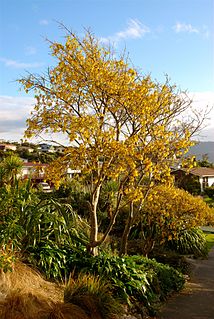
Sophora microphylla, common name kōwhai, is a species of flowering plant in the family Fabaceae, native to New Zealand. Growing to 8 m (26 ft) tall and broad, it is an evergreen shrub or small tree. Each leaf is 10 cm (4 in) long with up to 40 pairs of shiny oval leaflets. In early spring it produces many racemes of pea-like yellow flowers.

Podocarpus is a genus of conifers, the most numerous and widely distributed of the podocarp family, the Podocarpaceae. Podocarpus species are evergreen shrubs or trees, usually from 1 to 25 m tall, known to reach 40 m (130 ft) at times. The cones have two to five fused cone scales, which form a fleshy, berry-like, brightly coloured receptacle at maturity. The fleshy cones attract birds, which then eat the cones and disperse the seeds in their droppings. About 97 to 107 species are placed in the genus depending on the circumscription of the species.

Podocarpus macrophyllus is a conifer in the genus Podocarpus, family Podocarpaceae. It is the northernmost species of the genus, native to southern Japan and southern and eastern China. Common names in English include yew plum pine, Buddhist pine, and fern pine. Kusamaki (クサマキ) and inumaki (犬槇) are Japanese names for this tree. In China, it is known as 羅漢松 or luóhàn sōng, which literally means "arhat pine".
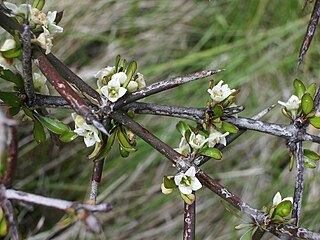
Discaria toumatou, commonly called matagouri, is a tangle-branched thorny plant endemic to New Zealand. An alternative but less used name for the plant is "wild Irishman". The name matagouri is how speakers of English heard the South Island pronunciation of the Māori name "matakoura". It is also known as tūmatakuru.

Melicytus ramiflorus is a small tree of the family Violaceae endemic to New Zealand.
Mahoe is a common name for several plants and may refer to:

Melicytus crassifolius is an ornamental plant of Violaceae family, which is native to New Zealand.
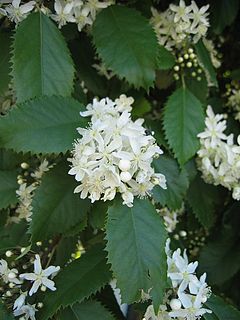
Hoheria is a genus of six species of flowering plants in the family Malvaceae. All are endemic to New Zealand. The genus name is a latinization of the Māori language name, houhere. That name, as well as lacebark and ribbonwood, are often used as common names. The name lacebark comes from the lace-like fibrous inner bark layer.

Melicytus is a genus of flowering plants in the family Violaceae. Hymenanthera is a synonym.

The Canterbury-Otago tussock grasslands are an ecoregion of South Island, New Zealand.
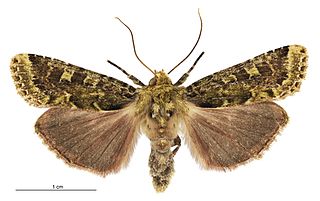
The mahoe stripper or green mahoe moth is a moth of the family Noctuidae. It is endemic to New Zealand. This moth was first described by Francis Walker in 1857 as Erana graminosa.
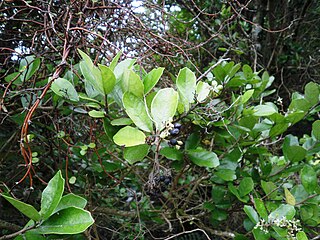
Pennantia corymbosa, commonly known as kaikomako, is a small dioecious forest tree of New Zealand.

Melicytus lanceolatus, commonly called narrow-leaved māhoe or māhoe-wao, is a small tree of the family Violaceae endemic to New Zealand.

Hoheria angustifolia, the narrow-leaved lacebark or narrow-leaved houhere, is a species of flowering plant in the family Malvaceae, endemic to New Zealand. It is an evergreen tree or shrub with a weeping habit and grows to 10 m (33 ft) tall. Known as Houhere or Houhi in Māori, the bark of the tree was occasionally used for traditional textiles, similar to the traditional use of Hoheria populnea.
Melicytus novae-zelandiae, commonly known as coastal mahoe, is a flowering plant in the violet family. It grows along the coast of New Zealand from the Bay of Plenty northwards, especially on offshore islands. Its range is largely restricted to New Zealand, though one subspecies is endemic to Australia's Lord Howe Island. The specific epithet refers to its principal area of occurrence.
Hemideina femorata, the Canterbury tree weta or in Māori, putangatanga, is a flightless nocturnal insect from the order Orthoptera and the genus Hemideina, it is endemic to Canterbury, New Zealand, on the South Island.

Austramathes purpurea is a species of moth in the family Noctuidae. It was first described by Arthur Gardiner Butler in 1879 from a specimen collected in Otago. It is endemic to New Zealand.

Austramathes pessota is a species of moth in the family Noctuidae. It is endemic to New Zealand.

Melicytus alpinus, the mahoe porcupine shrub, is a small shrub of the family Violaceae endemic to New Zealand.














